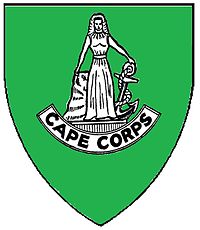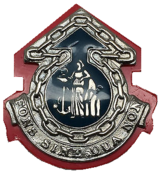
The South African Army is the principal land warfare force of South Africa, a part of the South African National Defence Force (SANDF), along with the South African Air Force, South African Navy and South African Military Health Service. The Army is commanded by the Chief of the Army, who is subordinate to the Chief of the SANDF.

The Lancashire Fusiliers was a line infantry regiment of the British Army that saw distinguished service through many years and wars, including the Second Boer War, the First and Second World Wars, and had many different titles throughout its 280 years of existence. In 1968 the regiment was amalgamated with the other regiments of the Fusilier Brigade – the Royal Northumberland Fusiliers, Royal Warwickshire Fusiliers and the Royal Fusiliers – to form the current Royal Regiment of Fusiliers.

The Rifle Brigade (The Prince Consort's Own) was an infantry rifle regiment of the British Army formed in January 1800 as the "Experimental Corps of Riflemen" to provide sharpshooters, scouts, and skirmishers. They were soon renamed the "Rifle Corps". In January 1803, they became an established regular regiment and were titled the 95th Regiment of Foot (Rifles). In 1816, at the end of the Napoleonic Wars, they were again renamed, this time as the "Rifle Brigade".

The South Wales Borderers was a line infantry regiment of the British Army in existence for 280 years.

The Nova Scotia Highlanders is an infantry regiment in the primary reserve of the Canadian Army. It is part of 36 Canadian Brigade Group, 5th Canadian Division.
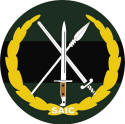
The South African Army Infantry Formation supervises all infantry within the South African Army.

The Chief Langalibalele Rifles is a reserve infantry regiment of the South African Army.

The 3rd Infantry Brigade was a Regular Army infantry brigade of the British Army, part of the 1st Infantry Division. Originally formed in 1809, during the Peninsular War, the brigade had a long history, seeing action in the Second Anglo-Afghan War, and during both the First and the Second World Wars.

The Cape Mounted Riflemen were South African military units.

The Battle of Blaauwberg, also known as the Battle of Cape Town, fought near Cape Town on Wednesday 8 January 1806, was a small but significant military engagement during the War of the Third Coalition, one of the Napoleonic Wars. After a British victory, peace was made under the Treaty Tree in Woodstock establishing British control over the Dutch Cape Colony. The Cape later became a permanent part of the British Empire following the Congress of Vienna that marked the end of the Napoleonic Wars in 1814. By establishing permanent British rule over the Cape Colony the battle would have many ramifications for the southern Africa region during the nineteenth and twentieth centuries. A bi-centennial commemoration was held in January 2006.
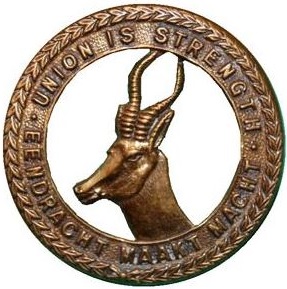
The South African Overseas Expeditionary Force (SAOEF) was a volunteer military organisation in World War I.
The 5th Battalion was an infantry battalion of the Australian Army. Raised in Victoria as part of the First Australian Imperial Force for service during World War I, the battalion formed part of the 2nd Brigade, attached to the 1st Division. It participated in the landing at Anzac Cove on 25 April 1915, coming ashore in the second wave, before taking part in the fighting at Krithia and then at Lone Pine. In December 1915, the battalion was withdrawn from the peninsula and returned to Egypt where it was involved in defending the Suez Canal until being transferred to the Western Front in France in early 1916. After that, over the course of the next two and a half years the 5th Battalion was rotated in and out of the front line and took part in a number of significant battles including at Pozieres, Ypres, Amiens and the Hindenburg Line. Following the end of the war, the battalion was disbanded and its personnel returned to Australia. The battalion was re-raised during the inter-war years as a part-time unit and was later mobilised during World War II, but did not serve overseas. During the post war period, the battalion has existed at various times before being subsumed into the 5th/6th Battalion, Royal Victoria Regiment.
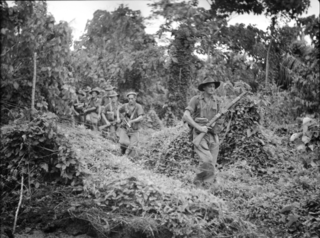
The 19th Battalion was an infantry battalion of the Australian Army. Although the unit's numerical designation was bestowed upon it during World War I, the unit can trace its origins back to 1860 when a Volunteer Rifle corps was raised in South Sydney. During World War I, the 19th Battalion was raised as a unit of the Australian Imperial Force, attached to the 5th Brigade, of the 2nd Division. The unit was formed in 1915 and was first sent to Gallipoli where it fought against the Turks, before being withdrawn from the peninsula and being sent to France in early 1916, where it served in the trenches along the Western Front. Over the next two years the battalion fought in many major battles and won numerous battle honours. In April 1918, it took part in defending against the German Spring Offensive, before the Allies launched their own last-ditch effort as part of the Hundred Days Offensive. The battalion was disbanded in October 1918 due to manpower shortages in the AIF and most of its men were sent to reinforce the other three battalions of the 5th Brigade.
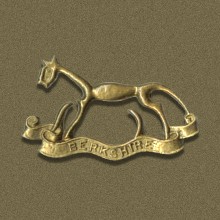
The Berkshire Yeomanry was a part time regiment of the British Army formed in 1794 to counter the threat of invasion during the French Revolutionary Wars. It was the Royal County of Berkshire's senior volunteer unit with over 200 years of voluntary military service. After taking part in the Second Boer War, it saw action as mounted troops in the First World War and as artillery in the Second World War. Its lineage is maintained by 94 Signal Squadron, part of 39 (Skinners) Signal Regiment. The Headquarters of the Squadron is based in Windsor, Berkshire. The Berkshire Yeomanry had a number of battle honours won from Europe to the Far East and Private Frederick Potts was awarded a Victoria Cross for service during the Gallipoli Campaign.

The North Staffordshire Regiment (Prince of Wales's) was a line infantry regiment of the British Army, which was in existence between 1881 and 1959. The 64th (2nd Staffordshire) Regiment of Foot was created on 21 April 1758 from the 2nd Battalion of the 11th Regiment of Foot. In 1881, under the Childers Reforms, the 64th Regiment of Foot was merged with the 98th (Prince of Wales's) Regiment of Foot (originally raised in 1824) to form the Prince of Wales's (North Staffordshire Regiment). In 1921 the regimental title was altered to the North Staffordshire Regiment (Prince of Wales's).
The Kensington Regiment (Princess Louise's) is a unit of the British Army, which originated in the Volunteer Rifle Corps' movement of the 1850s. In 1908 it became a battalion of the London Regiment in the Territorial Force. It was an infantry regiment from 1908 to 1940, a heavy fire support unit from 1940 to 1945, and has been a unit of the Royal Corps of Signals since 1945.
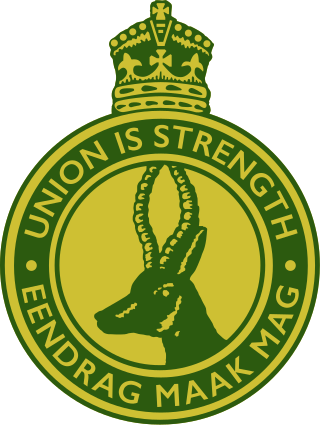
The Union Defence Force (UDF) comprised the armed forces of South Africa from 1 July 1912, when the Defence Act took effect, two years after the creation of the Union of South Africa, until 1957 when it was reorganised and renamed the South African Defence Force.

9 South African Infantry Battalion is a motorised infantry unit of the South African Army, designated seaborne.

The Korps Pandoeren, or Corps Pandoeren, was a light infantry unit raised in the Cape Colony from the Khoekhoe and mixed population to aid in the colony's defence. The unite was raised in 1793 following France's declaration of war with the Netherlands at the outbreak of the French Revolutionary Wars. The unit was disbanded by the British following the capture of the Cape Colony in 1806. The unit saw action during the Invasion of the Cape Colony in 1795 and the Battle of Blaauwberg in 1806. The corps was noted for its skill in fighting unconventional actions.
